The Openings for the Introduction of Zyklon B, Part 2
The Roof of Morgue 1 of Crematorium II at Birkenau
1. Analysis of a Forensic Investigation
1.1. Introduction
In the spring of 2004, Daniel Keren, Jamie McCarthy, and Harry W. Mazal published, as part of the Holocaust History Project, an article entitled “The Ruins of the Gas Chambers: A Forensic Investigation of Crematoriums at Auschwitz I and Auschwitz-Birkenau.”[1] In that study, the authors deal with the alleged openings for the insertion of Zyklon B on the roof slab of underground morgue 1 of crematorium II at Birkenau, and of the morgue of crematorium I at Auschwitz. To the second part of their “forensic investigation” I have already dedicated a specific article,[2] in which I have demonstrated that the claims of the authors are completely inconsistent.
In the present article, I shall examine the thesis brought forward by the authors in respect of morgue 1 of crematorium II.
Before we go into the matter itself, it must be stated that the authors have not mentioned, even in passing, my article “No Holes, No Gas Chamber,”[3] which is the most detailed revisionist study of this topic to date. They have preferred to bypass my evidence and my arguments which, therefore, retain their full demonstrative force.
Obviously, the authors’ decision to remain quiet about my article is a conscious and easily understandable move, just as their decision to remain quiet on Charles D. Provan’s text “No Holes? No Holocaust?”[4] – which is still the most serious treatment of this question on the Holocaust side – although in this case their motivation was different: they wanted to take advantage of Provan’s positive observations and at the same time shun his criticisms of the official thesis.
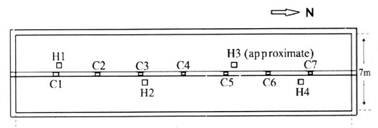
Document 1: Position of the alleged openings for Zyklon B (H1-4) in the roof of morgue 1 of crematorium II at Birkenau according to Daniel Keren et al.[5]
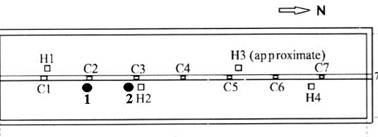
Document 1a: Position of objects 1 and 2 of the “train photo” on the roof of morgue 1 of crematorium II in relation to the alleged openings for Zyklon B and to the support pillars of the room. Source: cf. document 1.
Actually, while the authors add no new element of proof to Provan’s study, they take over his argumentative structure in terms of testimonies, and terrestrial and aerial photographs (pp. 3-5)
2. A Deceptive Method
The authors’ method is simplistic and deceptive: they start from the supposedly accepted fact that on the roof of morgue 1 of crematorium II at Birkenau there had existed four openings (with external protective chimneys and internal devices for the introduction of Zyklon B) and then claim to identify them on photographs and in the ruins of the building.
Deviating from Provan, the authors neither present nor analyze all the testimonies available in this regard, but base themselves almost exclusively on Henryk Tauber’s deposition of May 24, 1945, which, moreover, they know only through Pressac[6] and without quoting even a single line from it! The fact that they do not mention the most prominent witness on the question of the Zyklon B introduction devices either – Michał Kula – is not really surprising. His testimony is too much at variance with their alleged “findings”, and so they just ignore him!
Let us analyze, first of all, Tauber’s deposition:[7]
“The vault of the gas chamber rested on concrete pillars which were arranged lengthwise in the center. There were four columns right and left of these pillars. The outer part of these columns was made of a grid of thick wire which extended to the ceiling and to the outside. Within[8] this part there was a second netting with smaller mesh and openings and on the inside of this a third, dense, netting. In this third netting a can moved by means of a wire, with which the powder was extracted from which the gas had now evaporated.”
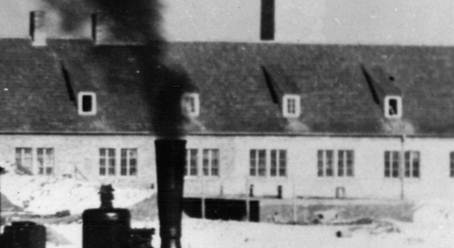
Document 2: Section of photograph of crematorium II at Birkenau, February 1943.[9]
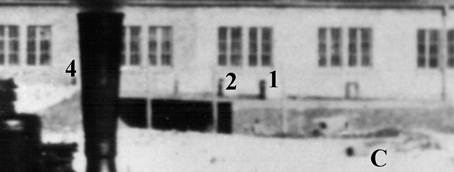
Document 2a: Section enlargement of Doc. 2. The numbers 1, 2 and 4 indicate the objects or alleged Zyklon B chimneys on the roof of morgue 1. The letter “C” indicates an object of cylindrical shape.
However, when he was first interrogated by the Soviets, on February 27-28, 1945, Tauber had declared:[10]
“The Zyklon gas diffused into the [gas] chamber through mesh columns which had a rectangular cross-section with walls of a double grid.”
Therefore, the alleged device was not yet constituted by a triple mesh, but a double one, and did not yet have a square cross-section, but a rectangular one.
The strength of the authors’ historical acumen and of their quest for the truth can be judged by their reference to another witness, Shaul Chazan (or Chasan):
“Were the wire mesh Zyklon insertion devices attached to the concrete support pillars? This hypothesis might appear reasonable, but we have found little support for it and strong evidence against it. Mr. Gideon Greif of Yad Vashem, an expert on the Auschwitz-Birkenau Sonderkommando, contacted at our request two Sonderkommando survivors who worked in Crematoriums II and III. Mr. Shaul Chazan and Mr. Lemke Phlishko both stated that the devices were not attached to the support columns.” (p. 72)

Document 2b: Section enlargement of doc. 2. Cf. document 1. Diagram of the positions of the three objects on the morgue.
In the book of this alleged “expert on the Auschwitz-Birkenau Sonderkommando”[11] there is also Shaul Chazan’s testimony. The dialog on the alleged Zyklon B introduction devices runs as follows:[12]
[Greif] You said that the gas was poured in through openings in the ceiling. Did it drop to the floor or on the heads of the people?
[Chazan] No, no, no: there were several openings there. From each opening a round grid column came down. The grid was made of metal, full of holes, from the window in the ceiling down to the floor, and the poison gas was dropped through this hollow pillar, in the form of little pebbles. Then the smell would spread, that was the gas.
[Greif] Did the grid column through which the gas was dropped reach all the way down to the floor?
[Chazan] Nearly to the floor. One had left a space which made it possible to clean there. One poured water out and brushed up the remaining pebbles.” (My emphases)
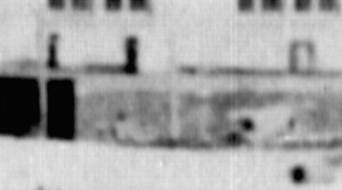
Document 2c: Section from doc. 2, objects #1 and #2.

Document 2d: Section from doc. 2, further enlargement of objects #1 and #2.
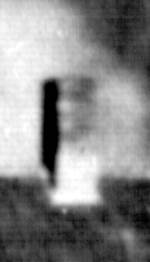
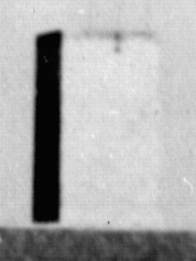
Document 2e: Section enlargement of doc. 2: ventilation chimney for morgue 1.
Document 2f: Section enlargement of doc. 2. Chimney of the Crematorium.
So this “eyewitness” who did not even know the number of alleged openings speaks of a device with a circular cross-section, not a rectangular one, of perforated metal instead of wire mesh, and without a movable core for the recovery of the inert residue of the Zyklon B, because in his device, the grains of gypsum fell through the metal tube directly to the floor and were removed from below rather than from above. As anyone can see, this is a testimony in perfect “agreement” with Tauber’s.
Apart from that, a pillar that did not reach the floor had to be fastened to the concrete pillars, because otherwise it would have been demolished by the hypothetical, panicking victims. Thus, if Gideon Greif did indeed get a testimony from Shaul Chazan recently about the question of how those wire mesh columns were fastened, this can only have been a directed answer agreed upon in advance. And by the way, who could seriously claim to remember more than 60 years later such minute details as the way certain equipment in a certain room was fastened?
In my article cited above I have stressed that the “eye witness” Miklos Nyiszli, as early as 1946, had anticipated this version when he spoke of[13]
“square sheet-iron pipes, the sides of which contained numerous perforations, like a wire lattice.”
3. The Problem
The question of the openings in the roof slab of morgue 1 in crematorium II at Birkenau has three interdependent aspects, which are related to the alleged devices for the introduction of Zyklon B:
- the brick chimneys with cement covers
- the openings as such
- the wire-mesh devices
The authors concentrate on the first two points, leaving completely aside the third, for which there is no material or documentary correspondence. While they do claim that in the context of the transfer agreement for crematorium II (March 31, 1943) the four “Drahtnetzeinschiebevorrichtung[en]” (wire mesh introduction devices) listed in the inventory of the basement constitute the “inner core” of the alleged devices (p. 69) they forget, however, that in this document[14] these parts are attributed to morgue 2[15] and not to morgue 1 (the alleged homicidal gas chamber) and that they are accompanied by “4 Holzblenden” (4 wooden covers), which are claimed to be the lids of the chimneys for the Zyklon B. According to Tauber, however, the alleged lids were made of cement, and therefore the authors must have thought it would be safer not to mention these wooden covers at all.
In practice, as I have demonstrated in the article “No Holes, No Gas Chamber(s),” the alleged wire-mesh devices for the introduction of Zyklon B were never built, and so in this regard the “concordant” testimonies of Kula and Tauber are actually in agreement only in that they are untrue.[16] And this demonstration, by itself, demolishes the claims of the authors.
As far as the first two aspects of the problem are concerned, the authors assume – on the basis of Tauber’s testimony – that on the roof slab of morgue 1 there were four brick chimneys with cement covers,[17] which contained four openings arranged – in the same way as the chimneys – alternating to the left and to the right of the central beam, according to the drawing in Fig. 2a on p. 79 (see document 1). Neither Tauber nor any other witness, however, ever stated that the chimneys and the holes were situated next to pillars 1, 3, 5 and 7 of the morgue, as the authors assume, and from this point of view their hypothesis has no correspondence in testimony.
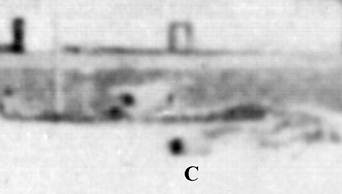
Document 2g: Section from doc. 2. Cylindrical object at the southern wall of morgue 1.
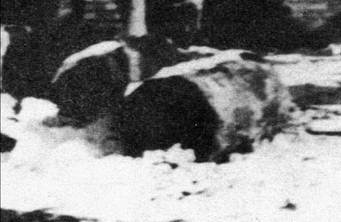
Document 2h: Photo of crematorium II from January 1943. Section enlargement of a cylindrical object (Metal barrel) in the foreground.[18]
The authors have, furthermore, evaded another and certainly not irrelevant question: that of the dimensions of the holes, clearly given by Kula. We shall later on elucidate why they prefer to remain silent on this point.
4. The Objects on the “Train Photograph”
In their effort to demonstrate the presence of the four presumed holes on the roof slab of morgue 1, the authors utilize three photographs – one terrestrial and two aerial.
The first is the well-known shot from the “Kamann” series of February 1943, which has been published and analyzed by Jean-Claude Pressac.[19] Because of the presence in the foreground of a small locomotive with several little cars, the authors call it the “Train Photograph”.[20]
In its background, this photograph shows morgue 1 of crematorium II, on top of which there are four unidentifiable objects, which D. Keren and his colleagues take three to be the chimneys for the introduction of Zyklon B. As results from their Fig. 4 on p. 80, they claim to have identified the first two chimneys, starting from south; the third one is said to be “entirely occluded by the smokestack” of the engine (p. 71) whereas the fourth appears for them “just to the left of a locomotive’s smokestack” (p. 71, see document 2a.). The analysis of this photograph by the authors is extremely superficial and skirts purposely many essential elements.
1. First of all, let us state that the presence of chimney # 3 behind the smokestack of the locomotive is pure conjecture and does not result from the photograph.
2. Secondly, the claim that the three indistinct objects, which one can see on the roof slab of morgue 1, are introduction chimneys for Zyklon B, is likewise an undemonstrated and not demonstrable assumption, which is even, as we shall see under item 7, contrary to the evidence.
The authors attempt to lend weight to their claim by bringing in two likewise known aerial photographs of the Birkenau area taken on 25 August 1944, with which I shall deal in the next section. Anticipating their later arguments, they in fact state the following conclusion:
“That the holes alternate in Crematorium II is supported by the aerial photograph, the Train Photograph, the physical findings, and Tauber’s testimony:” (p. 72)
3. Actually, the indistinct objects taken by the authors to be chimneys 1 and 2 for Zyklon B are both situated on the eastern half of the roof of the mortuary, as shown by the corresponding diagram (see document 2b), which is at variance with their basic thesis.
4. If one calculates the position of objects 1 and 2 along the median of the surface of the morgue, it results from this diagram that they stood at 7.2 and 10.5 m from the southern end of the morgue. This is fully borne out by the diagram prepared by Provan on which I have marked by numbers 1 and 2 the position of the respective objects (see document 2i).
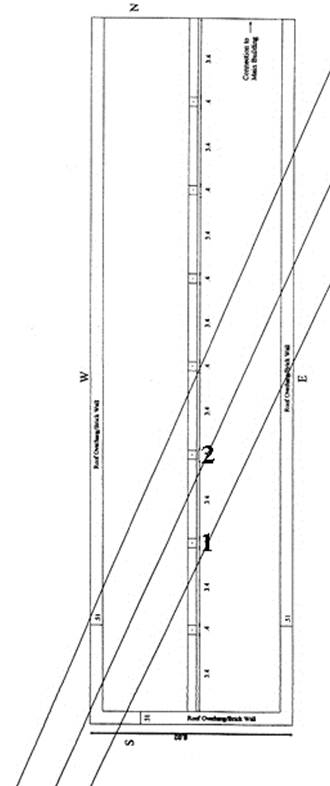
Document 2i: Triangulation diagram for the objects #1 and #2 on the roof of morgue 1 of crematorium II, drawn by C.D. Provan.[21] My numbers 1 and 2 mark the position of the respective objects. The third (left-most) line refers to an object, which D. Keren et al. do not consider to be a chimney for Zyklon B.
This means that object 1 is situated next to pillar # 2 and east of the central beam, whereas D. Keren et al. claim that the alleged chimney 1 is next to pillar # 1 and west of the central beam. Object 2 is about 3.3 m away from object 1, whereas, according to D. Keren et al., the alleged chimneys 1 and 2 should be located about 7.6 m apart. In document 1a, I have indicated on the diagram of D. Keren et al. the position of objects 1 and 2 with respect to their alleged Zyklon B chimneys 1 and 2.
5. According to D. Keren et al., object 4 should be located slightly in front of the last pillar of the morgue, hence some 4 m from the wall of the crematorium. Instead, it is touching the wall and its height is therefore 45 cm – half the distance between the pair of windows to its left and the plane of the morgue. The windows of the crematorium were, in fact, some 90 cm above the plane of morgue 1, as shown by drawing 1173-1174 (p)[22] and confirmed by the “Train Photograph”; thus the height of the object is half this distance.
If instead the object had been at the position indicated by the authors, it would be even lower because of the perspective. Already on plan 936 of January 15, 1942,[23] and in the later ones as well, a layer of earth had been specified for the top of morgue 1; plan 109/16a dated October 9, 1943, gives the exact thickness of this layer: 50 cm.[24] It follows that object 4, rising less than 50 cm above the concrete surface of the morgue, would have been buried in this layer of earth, therefore it could not have been a chimney for Zyklon B.
6. To the left of object 2 is another object on that roof. But because it obviously has a noticeably different shading and shape and because it is located at an inconvenient location, D. Keren et al. simply claim that this can not be a Zyklon B chimney. But if we are certain that there is at least one object on that roof which is not a Zyklon B chimney, is it not possible that the objects 1, 2, and 4 were “other” objects as well?
7. What may these objects have been? The photograph in question does not allow us to solve this riddle, but there is another photograph, also from the Kamann series, taken a few weeks earlier, which shows the morgue of crematorium II in greater detail (see document 3). On this photograph the alleged chimneys for Zyklon B do not appear at all. In my article cited initially I have already demonstrated that the hypothesis of a creation of holes in the ceiling of morgue 1 for the introduction of Zyklon B is technically absurd and also in total disagreement with one of the principal tenets of the official thesis shared also by the authors.[25]
In the photograph just mentioned, there is, on the roof of the morgue, an object with square sides, leaning against the wall to the left of the third pair of windows, which seems to be made up by a pile of boxes (see documents 3 and 3a). It is odd that the position of this object corresponds exactly to the alleged chimney 4 of the “Train Photograph”. We may have here an alternative explanation of chimney # 4.
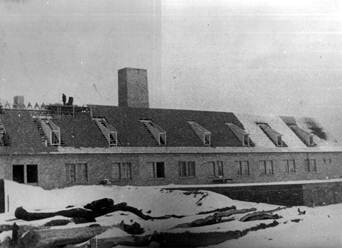
Document 3: Photography of crematorium II in Birkenau, January 1943.[26]
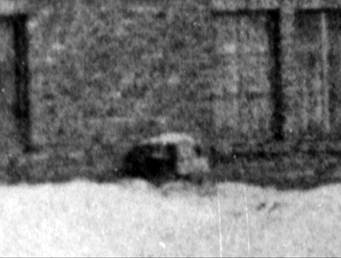
Document 3a: Section enlargement of doc. 3.
8. Let us move on to the other two objects. D. Keren et al. assume as an established fact that they were rectangular in shape and answer D. Irving’s hypotheses as follows:
“David Irving has speculated that the holes are really ‘drums containing sealant,’ but it is obvious that this cannot be the case: a cylindrical object would produce a gradual light pattern, while the objects above display a sharp change between uniform light and uniform shadow.” (p. 71)
Actually, this is anything but “obvious.” As is shown by an enlargement of objects 1 and 2, they have a shape that is rounded at top and bottom (see documents 2c and 2d), which is absolutely incompatible with the shadow zones of a parallelepiped; this also results from a comparison with one of the ventilation chimneys of the crematorium (document 2e) and the chimney of the ovens (document 2f).
It is therefore clear that the objects have a cylindrical shape.[27] But an object, cylindrical in shape, appears clearly just in front of the south wall of the morgue (see document 2g). Its dimensions, considering that the cylinder is right against the wall, are compatible with the two objects located on top of the morgue. We have here, no doubt, drums that were used during the construction. A similar cylinder, identifiable as a metal barrel, appears also in a photograph, which shows the erection of the chimney of crematorium III (document 2h). David Irving’s hypothesis therefore remains the most probable one.
5. The Marks on an Air Photo of August 25, 1944
Let us move on to the second alleged proof of the existence of four chimneys for Zyklon B on the roof slab of morgue 1 in crematorium II. The two aerial photographs of August 25, 1944,[28] in particular the one labeled 3185 (see doc. 4), show on this surface four dark spots of irregular shapes which the authors explain as follows:
“The smudges are too large to belong just to the holes themselves. They probably correspond to the tamping down of a trail on the roof by the SS men detailed to introduce the canisters. The photograph shows the smudges alternating slightly, Holes 1 and 3 to the west, 2 and 4 to the east. A Sonderkommando survivor, Henryk Tauber, considered a reliable witness on technical issues, testified that the holes in Crematorium II were on alternating sides.” (p. 72)
The authors had the photographs analyzed by “an expert on aerial photo interpretation, Carroll Lucas”, none other than the “expert” previously picked by that expert in trickery, John C. Zimmerman![29] A few pages on, they report his findings:
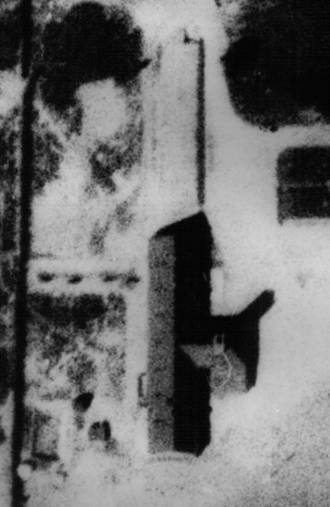
Document 4: Crematorium II at Birkenau in the aerial photograph of August 25, 1944.[30]
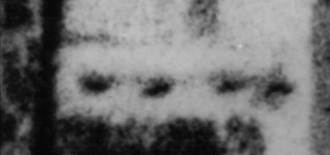
Document 4a: Section enlargement of doc. 4.

Document 4b: as doc. 4a. Position of dark spots.
“It is impossible to observe the Zyklon holes themselves in any of the aerial photographs. […].
Mr. Lucas analyzed the two August 25 photos showing the roof of the Crematorium II. […]. After careful study Mr. Lucas identified four small objects within the smudges, all slightly elevated above the level of the roof. Stereo imaging allows observation of even small objects in grainy images, very difficult or impossible to detect in separate images, as is well demonstrated by ‘random dot stereograms.’ In all probability, these correspond to the four ‘chimneys’ above the holes in the roof, as clearly visible in the Train Photograph. Thus, the aerial photographs add further support to the witness testimonies and to Train Photograph. With regard to the dark smudges and related findings Mr. Lucas summarized his conclusions as follows:
a) ‘The roof of the partially underground wing of the Crematorium contains four raised vents, possibly with covers larger than their exits’.
b) ‘The four dark areas observed on the Crematorium II roof (on positive prints) are compacted soil, produced by the constant movement of personnel deployed on the roof, as they worked around the vents.’ […].
c) ‘The thin dark lineation (on positive prints) interconnecting the dark areas is a path of compacted earth produced by personnel moving from vent to vent.’
d) ‘The dark area connecting this path to the edge roof from the vent nearest to the Crematorium roof is an extension of the path which shows where personnel gained access to the roof – possibly using a short ladder leaned against the roof.’
e) ‘The evidence provided by this analysis lends credence to the fact the vents existed and were used in a way consistent with statements from multiple witnesses.’” (pp. 95f.)
We will look at the soundness of these observations.
I note, first of all, that the claim of the authors that “the photograph shows the smudges alternating slightly, Holes 1 and 3 to the west, 2 and 4 to the east” is wrong. It is sufficient to delineate the shape of the morgue and to draw in the central beam that ran through it lengthwise to see that, in reality, the four smudges are all on the eastern half of the roof slab, as is clearly shown in document 4b. This deals the authors’ thesis a decisive blow.
Their comment on Lucas’ observations is really incredible: they state that “it is impossible to observe the Zyklon holes themselves”, but still Lucas did identify “four small objects within the smudges,” which, however, are “very difficult or impossible to detect in separate images.” In other words “the four small objects” cannot be seen, but – in an act of faith – they still have to be there! Finally, these objects, invisible as they are, correspond “in all probability” to the chimneys for Zyklon B!
What are Lucas’ observations?
a. He claims that the cover of morgue 1 shows “four raised vents, possibly with covers”: but how can he make a statement like that if it is impossible to observe the four alleged objects in separate images? And how was he able to see even the covers (!) of the alleged chimneys?
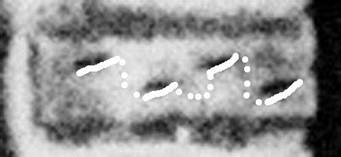
Document 4c: Dark smudges on the roof of morgue 1 of crematorium III (from same photo as doc. 4): allegedly caused by SS men walking from one chimney to another. But consider the path they must have taken: walking in an angle for 4 meters, then leaping to the next spot!
Here, our “expert” has been somewhat imprudent, because he uses the term “vents.” Now, as the authors explain in the introduction, the alleged openings for the introduction of Zyklon B are “sometimes called vents” (p. 68) in English. As the objects are invisible and hence unidentifiable, Lucas’ statement is not technical but purely propagandist: he simply claimed to have seen what the authors had wanted him to see. This ideological and propagandistic character of Lucas’ declarations clearly shows through also in his further statements.
b. He claims that the smudges one can see on the cover of the morgue “are compacted soil, produced by the constant movement of personnel deployed on the roof, as they worked around the vents.” Even assuming that this is technically sound – which, as we will see, it is not – we again run into the propagandist motivation: the smudges were caused by the personnel assigned to the gassings! How does he know that? An impenetrable mystery!
Let us analyze his technical explanation. The Birkenau area is known to be sandy. On the photograph in question the soil of the inner yard of crematorium II (but also at crematorium III) is white, except for areas with flower beds or vegetation. So, by what extraordinary physico-chemical phenomenon would the white sand have become black when it was repeatedly walked on by a pair of SS men?[31]
The authors come up with yet another and even more nonsensical explanation. The “inner core” of the columns, i.e. the alleged movable “can” into which the Zyklon B was poured, had been “temporarily removed and propped against the small chimney that housed the Zyklon insertion devices” (p. 97). But, according to Kula, this “can”
“was an empty column made of a thin zinc lamina with a square section of about 150 mm.”[32]
It was correctly drawn by Pressac.[33] But if the Zyklon B chimneys, which according to the authors measured “about 60 x 60 cm” (purely invented dimensions), are completely invisible in the photographs in question, how can anyone claim that devices 15 by 15 cm and at most one meter long could create smudges of some 3-4 meters?
c. Lucas’s statement that the four smudges are linked to “a path of compacted earth produced by personnel moving from vent to vent” is likewise propagandist. As long as the objection in relation to the change of color of compacted sand remains valid, on what grounds can one assume that the presumed compacting had produced “a path” and that it had been produced by the SS personnel allegedly assigned to the gassings?
d. Lucas claims furthermore to have identified, west of the fourth dark spot, the access “where personnel gained access to the roof”. It takes some imagination to see in this extension of the smudge a footpath, all the more so since this extension finishes half-way between the smudge and the outer edge of the morgue (see doc. 4a). And if applied to morgue 1 of crematorium III, it becomes totally absurd (see document 4c): There the dark smudges run in a distinct angle, which would mean that the SS men were walking from one chimney to another in odd angles for some 3-4 meters, then suddenly leaping 3 to 6 meters to the next spot – without run-up!
That Lucas’ observations have no technical relevance but are only propagandist in nature results finally from an important fact, to which he has obviously paid no attention at all. The ground of the yards in crematoria II and III consisted of the same sand which (presumably) covered morgues 1 and 2. From the point of view of the official historiography, if Lucas’ explanation were true, the thousands upon thousands of Jews who had trodden this sand before being gassed in these two crematoria should have created a literal highway of dark sand, from the gate of the yard to the entrance of morgue 2, the alleged undressing room. But the aerial photographs do not show even the slightest trace of supposedly compacted dark sand. But then how can anyone seriously argue that the smudges on morgue 1 have been caused by the sand being compacted under the boots of two men?
This shows how much the opinion of this “expert” is really worth.
The aerial photographs of May 31, 1944, are known for not showing dark spots on the roof of morgue 1 of the crematorium. This is how the authors explain that fact:
“One possible explanation is that the camouflage in the Crematorium area in general, and the gas chamber in particular, changed over time. […]
It is therefore reasonable to assume that between May 31 and July 8, the earth banks were flattened and the roof covered with earth. This newly placed earth was compacted by the SS-men climbing onto the roof and walking between the holes.” (p. 96)
I will stress, first of all, that the conjecture of the authors regarding the nature and the development of the spots is unfounded. Secondly, the camouflage of the crematoria consisted merely of a fence to be built around them. The respective order was given to the Central Construction Office by SS Brigadeführer Hans Kammler, head of Office Group C at the SS-WVHA, by telegram on May 12, 1944.[34] On May 16th, SS Obersturmführer Werner Jothann, head of Central Construction Office, drew up a list of the quantities of steel needed for the fence,[35] which, according to the respective “situation map,” was to be a rectangle of 100 m by 125 m around each of the crematoria II and III, and of 75 m by 100 m around crematoria IV and V.[36]
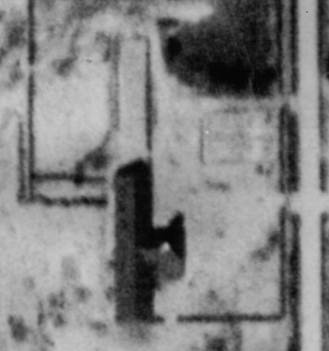
Document 5: Crematorium II in Birkenau in in an aerial photograph of May 31, 1944.[37]
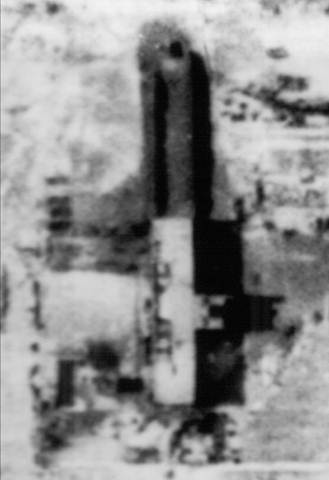
Document 6: Crematorium II in Birkenau in an aerial photograph on Dec. 21, 1944.[38]
The aerial photographs of May 31, 1944, show, for crematorium II, a fence that is nearly complete, except for the south-east corner (see doc. 5). A letter from SS Sturmbannführer Karl Bischoff (then head of Construction Inspectorate of the Waffen-SS “Schlesien”), dated May 17, 1944, explains that the fences were “Security measures (camouflage) of the crematoria in KL Lager II Auschwitz.”[39] In this context, one cannot understand the sense of “camouflaging” the morgues 1 by covering them with sand. We have already seen that the earth cover was already specified in plan 936 of the crematorium, dated January 15, 1942. A further photograph from the Kamann series published by Pressac,[40] probably dating from the summer of 1943, shows the southern part of morgue 1 covered by sand and grass[41] which, in perspective, almost touches the seventh and eighth pair of windows (from north). As opposed to this, the surface of the roof of the morgue in the “Train Photograph”, published by Pressac on the opposite page, appears to be much lower with respect to the windows of the crematorium.
Summarizing, in the summer of 1943 morgue 1 of crematorium II was surely covered with a layer of sand; later, the sand is supposed to have been removed from the roof of this room and then put back some time between May 31 and July 8, 1944. Such a hypothesis on the part of the authors is really not very “reasonable.”
In my article mentioned above I have explained the spots on the morgues, assuming that in 1944 the roof was devoid of sand, as results clearly already from the first photograph of the ruins of morgue 1, dating from 1945.[42]
The aerial photograph dated December 21, 1944, confirms this fact (see doc. 6). It shows crematorium II being dismantled. Morgue 2 appears to be uncovered; the roof and a large portion of the chimney have been taken down. Morgue 1 shows quite angular contours, which means that the concrete cover was surely laid bare.
On the roof slab one can see two dark spots, more or less where spots 3 and 4 appeared in the photograph taken on August 25, 1944. Parallel to them there are two more spots along the eastern edge of the roof slab. Another, fainter spot appears roughly where the first spot shows up in the photograph of August 25, 1944, but it extends eastward into another equally faint spot. The second spot of the photograph of August 25, 1944, does not show up this time. Together, this confirms that the explanation of the spots given by the authors is completely unfounded.
6. The Openings in the Ruins of the Roof Slab of Morgue 1 in Crematorium II
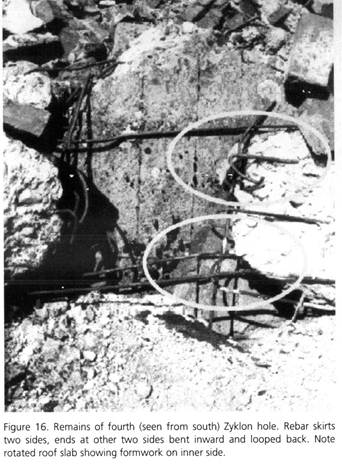
Document 7: The alleged opening #4 for Zyklon B.[43]
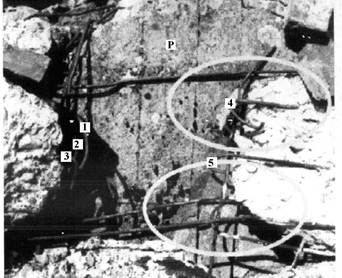
Document 7a: as doc. 7, the pillar and the bent rebars marked.
The authors claim to have found, in the ruins of morgue 1 of crematorium II “strong physical evidence” (p. 73) of three out of the four presumed holes for the introduction of Zyklon B.
Before we take a closer look at their “discoveries,” it is necessary to make a few remarks.
1. First of all, the authors refer to an “architectural rule”, already distorted by Provan, according to which[44]
“when violent stress is put on a concrete structure, cracks show up passing through holes made previous to the violent force, since the holes makes the structure weaker in that location.”
The authors use Provan’s untenable hypothesis and argue, that the violence of the explosion would have broken up the smooth edges of the alleged openings which, therefore, are no longer recognizable as such. Actually, as I have demonstrated by means of photographs, the smooth edges of the five rectangular ventilation openings in the ceiling of the furnace hall of crematorium III and of the round opening of the de-aeration tube in the ceiling of morgue 2 of crematorium II have remained practically intact in spite of the violent explosion, which ripped the rooms apart; The respective openings are perfectly identifiable as such.[45]
2. The identification of the alleged openings was done by the authors at home in their office, and in the most wilful manner: they have simply selected from the large number of holes and cracks of all shapes and sizes, which can be found in the ruins of the roof of morgue 1, those that are closest to their assumed pattern of the positions of the alleged openings for the introduction of Zyklon B.
3. In their fictitious identification, the authors have been careful to leave out the most important testimonial element regarding the dimensions of the alleged openings, because none of the holes they have so laboriously identified agrees with these dimensions.
Michał Kula, the self-styled maker of the alleged wire-mesh columns for the introduction of Zyklon B, has in fact declared that they had a square cross-sectional area of 70 cm × 70 cm and were 3 meters high, thus rising through the ceiling and protruding from it by (300 – 241 – 18 =) 41 cm.[46] For the installation of such a device it was therefore necessary to make an opening in the reinforced concrete slightly larger than 70 cm × 70 cm. Any brick chimneys would have measured at least (12 + 70 + 12 =) 94 cm × 94 cm (and not 60 cm × 60 cm, as the authors assert), because the standard bricks of the type “Altes Reich” at the time had a thickness of 12 cm.
4. Finally, the authors assume that the ruins at the time of their investigations (1998 – 2000) were exactly the same as those at the end of 1944 when the SS blew up crematorium II – as we shall see, this is a totally unsound hypothesis.
6.1. Opening #1
The authors state:
“Hole 1 is the opening in the roof near Pillar 1 (Figure 11a). The pillar remains standing and protrudes through the surface of the roof (Figure 10b), which shifted as it collapsed. While it might appear at first glance that the opening could just as easily have been created by the explosion, careful examination proves thus was not the case. Portions of straight, flat edges and a 90-degree angle survive intact, though most of the concrete around the edge was damaged by explosion. The center of this hole is 4.1 m from the southern end of the roof slab, and 0.75 m west of the roof’s center. We estimate its size approximately 0.5 m square; this places its eastern edge at 0.3 m west of the western edge of the central support beam.” (pp. 74f.)
This opening corresponds to Provan’s opening # 2. In the article mentioned at the beginning of this text I have already amply demonstrated that this is not an original opening but was produced by the Soviets or the Poles in 1945.[47]

Document 8: Morgue 1 of crematorium II at Birkenau. Concrete pillar protruding from concrete roof slab and the crack produced by the pillar. August 2000. © Carlo Mattogno.
I will add here that the claim of the authors that, in this opening, “portions of straight, flat edges and a 90-degree angle survive intact, though most of the concrete around the edge was damaged by explosion”, is true, albeit on a very small scale, but, as I have demonstrated by means of photographs which I have taken over the years, this rough squaring of the hole was carried out between 1992 and 1997 by a pious pair of hands from the Auschwitz Museum wanting, in this way, to render the tale of the Zyklon B openings more credible. In this respect, I have in fact stated:[48]
“Between 1992 (photograph 14) and 1997 (photograph 15) the hole has been coarsely enlarged and squared by blows with a chisel.
As can be seen from a comparison of the photographs 16, 17 and 18, hole no. 2 appearing in the photograph of 1945 has been successively enlarged, especially in its eastern part.”

Document 9: One of the supporting blocks for lamps in the ceiling of morgue 1 of crematorium II at Birkenau. October 1991. © Carlo Mattogno.
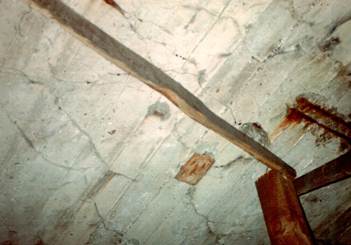
Document 10: Another one of the supporting blocks for lamps in the ceiling of morgue 1 of crematorium II at Birkenau. October 1991. © Carlo Mattogno.
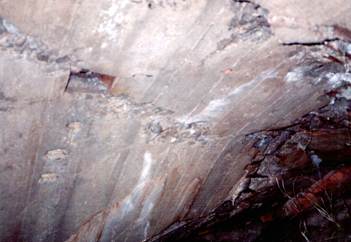
Document 11: Recess in the concrete ceiling of morgue 1 of crematorium II at Birkenau for a supporting block for the lamps. July 1992. © Carlo Mattogno.
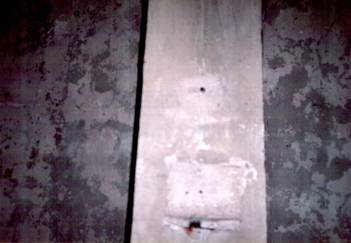
Document 12: Morgue of crematorium I at Auschwitz. One of the blocks set into the center of the supporting beam of the ceiling. October 1991. © Carlo Mattogno.
When it comes to the dimensions of the opening, the authors state that it measures about 0.5 meters square. In June 1990, this opening had a trapezoidal shape, the longest side measuring 86 cm, and a maximum width of 50 cm, the narrowest being 43 cm. However, as already stated, according to the witness Kula, the openings should have been at least 70 by 70 cm. One can thus easily see why the authors do not even in passing speak of Kula!
Van Pelt had already prepared a little sleight of hand to solve this problem. He had, in fact, presented a drawing,[49] which purports to show the make-up of the device described by Kula but which actually contains a diverging and arbitrary element: a constriction of the column at the level of the ceiling, with the width of the device dropping from 70 cm in morgue 1 itself to 48 cm within the roof slab and on the outside. The authors will, no doubt, resort to this sleight of hand when they are confronted with Kula’s testimony.
6.2. Opening #2
Opening 2, as results from figure 12 reproduced by the authors on p. 85, is the same as Provan’s opening #6. Actually, we are dealing here with a simple fissure caused by the crash of this part of the ceiling onto the sustaining pillar #6; this is shown clearly by my photographs 27 and 28.[50] In an effort to create the illusion that this crack is instead an opening that existed before the explosion, the authors are obliged to use a tedious expedient: to draw into this shapeless crack a dotted square which is to show the outline of the presumed original opening. To this square, they assign sides of 0.5 by 0.5 meters (p. 75), again at variance with those given by Kula: 0.7 by 0.7 meters.
6.3. Opening #3
In this respect, the authors write:
“Hole 3’s projected location is in an area of the roof that is badly damaged and covered with rubble”.
Unfortunately they had not received permission from the Auschwitz Museum to disturb the rubble (p. 75), so the presumed opening does exist, but it cannot be seen!
In reality here, too, the authors again take recourse to an ordinary trick. Their photograph of the area in question (figure 15 on p. 85) presents a very restricted field of vision and was taken from the west looking east. It is sufficient to widen the field of vision and to invert the position (from east looking west)[51] to realize that this area is not only not particularly “badly damaged” but that we have here two long cracks (one of which is Provan’s opening #8). These cracks have so little in common with the alleged openings for Zyklon B that the authors preferred to remain quiet about them and would rather have us believe that an invisible opening 3 does indeed exist!
6.4. Opening #4
The identification of opening 4 is decidedly more fanciful. The authors explain:
“Hole 4 can be identified by a pattern in the rebar (Figure 16) at the very northern end of what remains of the roof. […] Hole 4 can be identified by the unimpeded square opening set in the rebar in 1943. The surrounding edges were shattered by the explosion and the folding of the roof, leaving only the telltale rebar latticework. Its measurements are 0,5 x 0,5 m. […] The deliberately looped rebar proves that this hole, as almost certainly the other three, was cast at the time the concrete was poured in January 1943.” (pp. 75f.)
Let us examine the photograph of this alleged Zyklon B opening (see documents 7 and 7a). The first thing that strikes the eye is the supporting pillar for the morgue ceiling, which protrudes from this hole; the vertical traces of the planking used in the construction of this pillar are clearly visible, as are the ends of the steel rods sticking out of its top. The crack is clearly the result of the ceiling crashing onto this pillar. In fact, as the authors concede, “the roof shifted considerably when it collapsed after the explosions,” which means that the ceiling rose and then fell back with its central beam out of line with the row of pillars, some of which pierced the ceiling. This is borne out by the fact that next to the alleged opening 1 one can see the top of the first concrete pillar, which has pierced the roof of the morgue creating an opening of its own (see document 8).
Secondly, this crack does not have proper sides, to say nothing of smooth edges, which would not have disappeared altogether as demonstrated by the vents of the furnace hall of crematorium III or the ventilation hole of morgue 2 in crematorium II.
Thirdly, in the square formed by the rebars, to which the authors attribute so much importance, the lateral bars have not been cut as would have been necessary to erect the brick chimneys around the opening, but only bent: in document 7a, I have numbered 1-5 those that can be seen best, with “P” standing for the pillar.
The claim of the authors that this square of rebars is a direct proof that it was created in 1943 is frankly ridiculous. Over the years, the ruins of morgue 1 of crematorium II have undergone work and manipulations on several occasions. I will limit myself to the best documented ones. First of all, as early as 1946 the ruins of morgue 1 were the object of soundings and diggings undertaken by the expert Roman Dawidowski who worked under the orders of judge Jan Sehn.[52]
In 1968, a group of Germans did precise archeological research and diggings at this site. Pressac has published four photographs thereof.[53]
Furthermore, between 1990 and 2000 the alleged opening 1 – as I have already stated – was enlarged and squared. Provan’s opening #7 has undergone similar manipulations: in 1990, it presented five rebars up to 40 cm long bent backwards; in 2000, the opening had been roughly squared and four of those rebars had been cut.[54]
How is it possible, then, to claim seriously that, in 1998, the status of the rebars in the alleged opening 4 reflects the original conditions? And how can one take such stupidity to be a “proof”? The authors just did not know what to base themselves on to “demonstrate” the existence of the fourth alleged Zyklon B opening!
7. Robert Jan van Pelt’s Hypothesis
In his brief for the Irving-Lipstadt trial, van Pelt has retained as “logical” that the alleged openings for Zyklon b in morgue 1 of crematorium II had been refilled by the SS before they blew up the ceiling of this room.[55]
The authors hold this hypothesis to be unfounded and support their opinion with these arguments:
“It has been further hypothesized that the difficulty of locating the four holes may have reflected their having been filled in before the destruction of the chamber. This does not seem likely for Crematoriums II and III. The original roof consisted of three layers: a thick stone aggregate concrete slab underneath; a thinner, finer sand-aggregate concrete mixture above; and waterproofing bituminous tar paper in the middle. It is unlikely that the SS would have thought it necessary to duplicate this work, or that they could have done so in four places without leaving a trace. There are considerable areas of the original ceiling visible from under the slab but these show no signs of tampering. In Crematorium I the holes were filled when the structure was converted to a bomb shelter for the SS (date unknown).” (p. 73)
Let me stress right away that, on account of a kind of understandable reticence, Keren, McCarthy, and Mazal did not want to come out and say that the author of such nonsense was none other than their greatest expert on Auschwitz, Robert Jan van Pelt!
Much more important, though, is the fact that the arguments used by the authors are exactly those I had used in the article mentioned initially, including the reference to the ceiling of the alleged gas chamber in crematorium I,[56] which presents clearly apparent traces of four round openings, which have been filled in but which have nothing to do with the alleged openings for the introduction of Zyklon B. ecific article,[2] A case in point? Whichever way it is, the authors have recognized the full validity of my argumentation.
8. “Additional Findings”
The authors present further “additional findings,” the most important of which, with respect to the presumed extermination, are the following three:
1. A Small Opening
The first is “a small rectangular 4 x 10 cm aperture” in the ceiling of the morgue (p. 93). The authors explain its function as follows:
“It was possibly fitted with a removable gasket that allowed the insertion of a detector to test the concentration of gas: it is known that the crematoriums were equipped for this purpose.” (pp. 93f.)
Aside from the fact that there is no proof of this opening being original, the authors’ explanation is funny rather than unfounded, because they, like all the other nincompoops of their ilk, believe that a “detector” for hydrocyanic acid was some kind of mechanical device that could be placed into the “gas chamber”. As all revisionist scholars know, the “Gasrestprobe” for hydrocyanic acid involved reactive cardboard strips soaked in a chemical solution which was prepared on the spot.[57] Hence, that opening, if it really is original, could be used for anything but what the authors maintain.
2. Shower Heads
The second “discovery” consists in the finding, within the area of morgue 1, of a disc from “a probable false showerhead” (figures 22 and 23 on p. 88), of which no one knows when or by whom it was thrown where the authors found it. Scenarios like this are not uncommon.
As early as the 1980s, Pressac had found near the hole, which the authors take to be opening 1, a cement cover of one of the inspection shafts of the sewer in the crematorium, which I, in 1991, found in the opening.[58] As we have already seen, Tauber had stated that the presumed chimneys for the Zyklon B had cement lids, and one of his zealous admirers must have felt a duty to create a “converging proof” by means of this kind of arrangement!
As far as the tale of the fake showers is concerned, so cherished in the holocaust literature, I have already demonstrated in another article that the Central Construction Office, within the framework of the “special measures for the improvement of hygienic installations” in the Birkenau camp ordered by Kammler in early May 1943, had planned a “shower installation for detainees” in the basement of crematoria II and III and that the 14 showers, which are mentioned in the transfer agreement for crematorium III of June 24, 1943 (inventory of morgue 1), belonged to this project and were real.[59]
3. Pieces of Wood
The final “discovery” of the authors is a series of rectangular blocks set into the ceiling of the morgue:
“A number of small (approximately 10 x 15 x 4 cm), rectangular cast indentations can be seen in the ceiling of the gas chamber. At least six of these are visible in those portions of the ceiling presently accessible from below. […] One important detail must be emphasized: the indentations containing the wooden blocks were purposely built into the ceiling of the gas chamber from the very moment the roof was built.” (p. 94)
These blocks had already been seen by Pressac in the 1980s: in his first book on Auschwitz he showed two photographs of them, assuming that they were wooden bases for fake showers.[60] The authors do not say so explicitly, but clearly want the reader to believe this; they claim, in fact, that “this fixture” – i.e. the disc of the alleged fake shower and the rectangular blocks – “undoubtedly formed part of the elaborate plan to keep the victims ignorant of their fate as long as possible” (p. 95). Is there any foundation to this explanation?
In June of 1990, having attentively read Pressac’s first book on Auschwitz, I went to Birkenau for the first time, accompanied by two engineers; one of our very first investigations concerned precisely these blocks, which I photographed repeatedly, also during my later visits (docs. 9 and 10). Inside the morgue I identified eight of them (including the empty holes in the concrete, which had originally contained them, doc 11). They are arranged in two parallel lines to the right and left of the central beam, at a distance of about 1.65 meters from the beam and about 1.90 meters from one another. The dimensions vary slightly (10 cm × 11 cm; 9 cm × 12 cm), the thickness is 4 centimeters. The individual pairs of blocks (or empty holes in the concrete) are located lengthwise, and alternating with respect to the pillars of the morgue.
What was the use of those blocks? If we follow Pressac, the architects of the Central Construction Office had thought up 14 fake showers in a space of 210 square meters in an effort to “fool” some thousand persons: not really much to “fool” so many people!
The inspection of the mortuary in crematorium I supplies us with the solution to this apparent mystery. Eight supporting beams of this hall present, in fact, in their center wooden blocks of the same type set into the concrete (see doc. 12). The lamps that now light up this room are fixed to three of them.
Therefore, these blocks were simply the bases, to which the lamps of morgue 1 were attached. This is confirmed also by a document. Plan 2197[b](r) of crematorium II, dated March 19, 1943,[61]shows the pattern of the lamps for this hall: eight pairs of lamps are arranged in two parallel rows on both sides of the central beam, at equal distance from the pillars, i.e. at 1.90 meters from one another.
This corresponds to the positions of the blocks in question. As far as the width of the morgue is concerned, the lamps are situated next to the central beam, but it is reasonable to assume that they were actually located in the middle of each of the two halves of this room, i.e. at an intermediate distance between the beam and the opposite wall (3.3 meters), hence at about 1.65 m from the beam where, in fact, the blocks can be seen. If they had really been at the place shown in the drawing, they would have provided poor illumination for their section of the hall, and even worse for the other side, because the central beam, with its thickness of 55 cm, would have created broad shadow zones.
The strange placement on the drawing of the pairs of lamps right next to the central beam, on either side, may have the following explanation: in the western half of the morgue we also have a waste-water channel, which ran lengthwise between the central beam and the opposite wall in such a way that if the lamps had been drawn in at the location where the blocks are situated, the symbol (a small circle with an x in the center) for the seven lamps on this side of the room would have been superimposed on the lines of the channel and confusion might have resulted.
9. Conclusion
The authors claim to have furnished a concordance of evidence regarding the existence of the alleged openings for the introduction of Zyklon B in the ceiling of morgue 1 of crematorium II at Birkenau, on the basis of Tauber’s testimony, the “Train Photograph” and their own archeological findings.
This concordance is, in practice, purely fictitious for the following reasons:
1. The wire-mesh devices for Zyklon B allegedly fabricated by Kula never existed, therefore Tauber who claims to have seen them, is a false witness like Kula.
2a. The “Train Photograph” shows fuzzy objects of irregular shape, which only with fanciful conjecture can be considered to be chimneys for the introduction of Zyklon B.
2b. The alleged chimney #3 does not appear on the photograph and its existence is an arbitrary conjecture.
2c. The three indistinct objects, which the authors take to be chimneys for Zyklon B, are all on the eastern half of the roof slab of the morgue, which is at variance with their basic theses.
2d. Object #3 can be identified as the object, which can be seen in the same position on the photograph of January 1943 and is therefore not a chimney for Zyklon B.
2e. Objects 1 and 2 had a cylindrical shape and could therefore not be chimneys for Zyklon B.
2f. Object 1 stands to the east of pillar #2 instead of to the west of pillar #1.
2g. Another object on the roof is ignored by Keren et al., because it does fit into their hypothesis neither by location nor by shape: it is not a Zyklon B chimney.
3a. On the aerial photographs of August 25, 1944, the chimneys are absolutely invisible and only fanciful conjecture allows the authors to affirm that they existed.
3b. The explanation of the smudges present on the ceiling of morgue 1 is absolutely erroneous.
3c. The smudges were all on the eastern half of the roof slab of morgue 1, which again is at variance with the fundamental thesis of the authors.
4a. The alleged openings for the introduction of Zyklon B that the authors claim to have “discovered” are not original.
4b. Opening #1 was created in 1945 by the Soviets or by the Poles.
4c. Opening #2 is a simple crack caused by the crash of this part of the ceiling on sustaining pillar #6.
4d. Opening #3, according to the authors themselves, is invisible.
4e. Opening #4 was created by the pillar which protrudes from it.
4f. The alleged openings for the introduction of Zyklon B “discovered” by the authors all have dimensions in disagreement with those indicated by the witness Kula.
4g. All openings are irregular in shape and do not have properly crafted edges; the reinforcement bars have not been removed; there is no trace of mortar.
4h. There are no traces in the concrete (ceiling, pillars, floor) of any steel columns for introducing Zyklon B had been fastened to it.
5. The blocks set into the ceiling of the morgue did not serve as bases for the fixation of fake showers, but for the attachment of lamps lighting up this room.
The alleged “forensic investigation” by Daniel Keren, Jamie McCarthy, and Henry W. Mazal thus has no value, be it historical or technical.
© Carlo Mattogno July 2004
Abbreviations
| APMO: | Archiwum Państwowego Muzem w Oświęcimiu (Archive of the National Museum at Auschwitz) |
| GARF: | Gosudarstvenni Archiv Rossiskoi Federatsii (State Archive of the Russian Federation), Moscow |
| NA: | National Archives, Washington D.C. |
| RGVA: | Rossiiskii Gosudarstvennii Vojennii Archiv (Russian State Archive for War), Moscow. |
Notes
| [1] | Holocaust and Genocide Studies, 9(1), spring 2004, pp. 68-103. |
| [2] | See the previous article in this issue. |
| [3] | See in this issue, pp. 387-410. An earlier version of this paper was posted online since 2002 on the website of Russ Granata, which does no longer exist; it was first published in German as “Keine Löcher, keine Gaskammer(n)”, Vierteljahreshefte für freie Geschichtsforschung 6(3) (2002), pp. 284-304; the old online version is now posted at www.vho.org/GB/c/CM/noholes.html. |
| [4] | C.D. Provan, “No Holes? No Holocaust? A Study of the Holes in the Roof of Morgue 1 of Krematorium 2 at Birkenau”. Printed by: Zimmer Printing, 410 West Main Street, Monongahela, PA 15063. © 2000 by Charles D. Provan. |
| [5] | D. Keren, J. McCarthy, H.W. Mazal, op. cit. (note 1), S. 79. |
| [6] | It is the English translation of the French translation published by Pressac in: Auschwitz: Technique and operation of the gas chambers, Beate Klarsfeld Foundation, New York 1989, pp. 481-502. |
| [7] | Höss trial, vol. 11, interrogation of Henryk Tauber on May 24, 1945, pp. 129f. |
| [8] | “Za”, literally “behind.” |
| [9] | Kamann-Serie, APMO Negativ Nr. 20995/504. |
| [10] | Statement by H. Tauber on February 27, 1945. GARF, 7021-108-13, p. 5. |
| [11] | G. Greif has limited himself to interviews with seven self-styled survivors of the so-called “Sonderkommando,” asking them banal questions, which show his very vague knowledge of the history of the camp. As a case in point, this “expert” did not even ask his partners how many Zyklon B holes there were! |
| [12] | G. Greif, Wir weinten tränenlos… Augenzeugenberichte der jüdischen “Sonderkommandos” in Auschwitz, Böhlau Verlag, Cologne/Weimar/Vienna 1985, p. 237. |
| [13] | C. Mattogno, op. cit. (note 3), p. 389. |
| [14] | RGVA, 502-2-54, p. 79. |
| [15] | Pressac has noted that drawing 2197 of crematorium II, dated March 19, 1943, “indicates that morgue 1 had 16 lamps and 3 taps and morgue 2, 10 lamps and 5 taps”, whereas the inventory attributes 5 taps to morgue 1 and 3 to morgue 2, therefore the two lines are inverted; hence, he ascribes an analogous inversion also to the 4 wire mesh introduction devices and to the 4 wooden covers, which would thus belong to morgue 1. (J.-C. Pressac, op. cit. (note 6), pp. 430 and 231). But as the number of lamps is correct for each one of the two morgues, nothing proves that the lines referring to the 4 wire mesh introduction devices and to the 4 wooden covers have been inverted; therefore, the irrefutable fact remains that these objects are attributed to morgue 2. |
| [16] | C. Mattogno, op. cit. (note 3), pp 407f. |
| [17] | Höss trial, vol. 11, interrogation of Henryk Tauber on May 24, 1945, p. 139. |
| [18] | J.-C. Pressac, op. cit. (note 6), photo 11, p. 337. |
| [19] | J.-C. Pressac, op. cit. (note 6), p. 340. Cf. document 2. |
| [20] | First analyses of this photo were made by Jean-Marie Boisdefeu (La controvers sur l’extermination des Juifs par les Allemands, vol. 1, Vrij Historisch Onderzoek, Berchem 1994, p. 168) and G. Rudolf (Das Rudolf Gutachten, 2nd ed., Castle Hill Publishers, Hastings 2001, p. 79; Engl.: The Rudolf Report, Theses & Dissertations Press, Chicago 2003, p. 113-116), though relying on low quality reproductions of this photo. |
| [21] | From: C.D. Provan, “No Holes? No Holocaust? A Study of the Holes in the Roof of Leichenkeller 1 of Krematorium 2 at Birkenau”, Zimmer Printing, 410 West Main Street, Monongahela, PA 15063, p. 33. |
| [22] | Data taken from the drawings of crematorium II published by J.-C. Pressac, op. cit. (note 6), pp. 286 and 325. |
| [23] | J.-C. Pressac, op. cit. (note 6), pp. 268f. |
| [24] | Ibidem, p. 329. The windows of the crematorium thus stood at hardly 40 cm above the surface of the layer of sand, which is confirmed by the photograph from the Kamann series of crematorium II in the summer of 1943. Cf. following section. |
| [25] | C. Mattogno, op. cit. (note 3), pp. 394-397. |
| [26] | Kamann series, January 1943. APMO, Negativ Nr. 20995/506. |
| [27] | The camera stood a little distance above the level of the morgue and this explains the fact that the two objects also had a rounded top. |
| [28] | Mission 60 PR/694 60 SQ. Can F 5367. Exposure 3185, 3186. NA. |
| [29] | J.C. Zimmerman, Holocaust Denial. Demographics, Testimonies and Ideologies. University Press, Lanham, New York, Oxford 2000, p. 243. |
| [30] | NA, Mission 60 PR/694 60 SQ. Can F 5367. Exposure 3185f., here 3185. |
| [31] | According to M. Nyiszli, two SS men were assigned to the alleged gassings: Auschwitz. A Doctor’s Eyewitness Account. Fawcett Crest, New York 1961, p. 45; Im Jenseits der Menschlichkeit. Ein Gerichtsmediziner in Auschwitz, Dietz Verlag, Berlin 1992, p. 36. |
| [32] | C. Mattogno, op. cit. (note 3), pp. 397. |
| [33] | Ibidem, p. 404. |
| [34] | RGVA, 502-1-229, p.11. |
| [35] | RGVA, 502-1-229, pp. 12f. |
| [36] | RGVA, 502-1-229, p. 14. |
| [37] | NA, Mission 60 PRS/462 60 SQ. Can D 1508. Exposure 3055. |
| [38] | NA, Mission 15 SG/995 5PG. Can D 1535. Exposure 4018. |
| [39] | RGVA, 502-1-313, p. 4. |
| [40] | J.-C. Pressac, op. cit. (note 6), p. 341. |
| [41] | In this photograph, which shows the eastern section of the morgue along a SW-NE diagonal, the grass forms a thick dark spot, which certainly covers at least the southern part of that section of the roof and which, in an aerial photograph, would have appeared precisely as a thick dark spot. |
| [42] | C. Mattogno, op. cit. (note 3), pp. 391. |
| [43] | Daniel Keren et al., op. cit. (note 1), p. 85. |
| [44] | C. Mattogno, op. cit. (note 3), pp. 398 |
| [45] | Ibidem, pp. 399f. |
| [46] | Ibidem, pp. 397f. |
| [47] | Ibidem, pp. 400-406. |
| [48] | Ibidem, pp. 403. |
| [49] | R.J. van Pelt, The Case for Auschwitz. Evidence from the Irving Trial, Indiana University Press, Bloomington/Indianapolis 2002, p. 208. |
| [50] | C. Mattogno, op. cit. (note 3), pp. 405. |
| [51] | Ibidem, photographs 28-30. |
| [52] | Ibid. p. 404. |
| [53] | J.-C. Pressac, op. cit. (note 6), p. 265. |
| [54] | C. Mattogno, op. cit. (note 3), pp. 402f., photographs 20-25. |
| [55] | R.J. van Pelt, The Pelt Report, Pelt Report, Gutachten im Verfahren von David John Cawdell Irving vs. (1) Penguin Books Limited, (2) Deborah E. Lipstadt, Queen’s Bench Division, Royal Courts of Justice, Strand, London, Az. 1996 I. No. 113., p. 295; The Case for Auschwitz, op. cit. (note 49), p. 406. |
| [56] | C. Mattogno, op. cit. (note 3), pp. 407. |
| [57] | “The ‘Gas Testers’ of Auschwitz,” in: TR, 2(2) (2004), pp. 140-154. |
| [58] | C. Mattogno, op. cit. (note 3), pp. 405, photograph 26. |
| [59] | Carlo Mattogno, “The Morgues of the Crematoria at Birkenau in the Light of Documents”, TR 2(3) (2004), pp. 276-278. |
| [60] | J.-C. Pressac, op. cit. (note 6), p. 488. |
| [61] | Ibid., p. 312. |
Bibliographic information about this document: The Revisionist 2(4) (2004), pp. 420-436
Other contributors to this document: n/a
Editor’s comments: n/a
